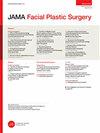Spontaneity Assessment in Dually Innervated Gracilis Smile Reanimation Surgery.
Q1 Medicine
引用次数: 28
Abstract
Importance Surgeons have sought to optimize outcomes of smile reanimation surgery by combining inputs from nerve-to-masseter and cross-face nerve grafts. An objective assessment tool could help surgeons evaluate outcomes to determine the optimal neural sources for smile reanimation. Objective To evaluate the use of a novel video time-stamping method and standard outcome measurement tools to assess outcomes of facial reanimation surgery using various innervation strategies. Design, Setting, and Participants Cohort study assessing the outcomes of dually innervated gracilis free muscle transfers vs single-source innervated gracilis transfer performed at a tertiary care facial nerve center between 2007 and 2017 using a novel, video time-stamping spontaneity assessment method. The statistical analyses were performed in 2018. Interventions Dually innervated gracilis free muscle transfers or single-source innervated gracilis transfer. Main Outcomes and Measures Spontaneous smiling was assessed by clinicians and quantified using blinded time-stamped video recordings of smiling elicited while viewing humorous video clips. Results This retrospective cohort study included 25 patients (12 men and 13 women; median [range] age, 38.4 [29.3-46.0] years) treated with dually innervated gracilis free functional muscle graft for unilateral facial palsy between 2007 and 2017. Smile spontaneity assessment was performed in 17 patients and was compared with assessment performed in 24 patients treated with single-source innervated gracilis transfer (ie, nerve-to-masseter-driven or cross-face nerve graft-driven gracilis [n = 13]) (demographic data not available for NTM and CFNG cohorts). The use of time-stamped video assessment revealed that spontaneous synchronous oral commissure movement in a median percentage of smiles was 33% in patients with dually innervated gracilis (interquartile range [IQR], 0%-71%), 20% of smiles in patients with nerve-to-masseter-driven gracilis (IQR, 0%-50%), and 75% of smiles in patients with cross-face nerve graft-driven gracilis (IQR, 0%-100%). Clinicians graded smile spontaneity in dually innervated cases as absent in 40% (n = 6 of 15), trace in 33% (n = 5 of 15) and present in 27% (n = 4 of 15). No association was demonstrated between clinician-reported spontaneity and objectively measured synchronicity. Conclusions and Relevance Dually innervated gracilis free muscle transfers may improve smile spontaneity compared with masseteric nerve-driven transfers but not to the level of cross-face nerve graft-driven gracilis transfers. Quantifying spontaneity is notoriously difficult, and most authors rely on clinical assessment. Our results suggest that clinicians may rate presence of spontaneity higher than objective measures, highlighting the importance of standardized assessment techniques. Level of Evidence 4.双神经支配股薄肌恢复微笑手术的自发性评估。
重要性外科医生通过结合神经到咬肌和交叉面神经移植的输入来寻求优化微笑恢复手术的结果。一种客观的评估工具可以帮助外科医生评估结果,以确定恢复微笑的最佳神经来源。目的探讨一种新的视频时间戳方法和标准结果测量工具在不同神经支配策略下面部再生手术效果评估中的应用。设计、设置和参与者:一项简短的研究评估了2007年至2017年间在三级护理面神经中心进行的双股薄神经支配肌肉转移与单源股薄神经支配肌肉转移的结果,采用了一种新颖的视频时间标记自发性评估方法。统计分析于2018年进行。介入无股薄神经支配肌转移或单源股薄神经支配肌转移。临床医生对自发的微笑进行了评估,并通过观看幽默视频片段时产生的带时间戳的微笑录像进行了量化。结果本回顾性队列研究纳入25例患者(男性12例,女性13例;2007年至2017年,中位年龄38.4岁[29.3-46.0]岁)接受双股薄神经无功能肌移植治疗单侧面瘫。对17例患者进行了微笑自发性评估,并与24例接受单源神经支配的股薄肌转移治疗的患者进行了比较(即神经到咬肌驱动或交叉面神经移植驱动的股薄肌[n = 13]) (NTM和CFNG队列无法获得人口统计数据)。使用时间视频评估显示,双神经支配的股薄肌患者自发同步口腔接触运动的微笑中位数百分比为33%(四分位数范围[IQR], 0%-71%),神经-咬肌驱动的股薄肌患者的微笑中位数百分比为20% (IQR, 0%-50%),交叉面神经移植物驱动的股薄肌患者的微笑中位数百分比为75% (IQR, 0%-100%)。临床医生对双神经支配病例的自发性微笑评分为40%(15例中有6例)没有,33%(15例中有5例)有,27%(15例中有4例)有。临床报告的自发性和客观测量的同步性之间没有关联。结论与相关性:双神经支配的股薄肌移植与咬肌神经驱动的股薄肌移植相比,可改善微笑自发性,但不如面神经移植的股薄肌移植。量化自发性是出了名的困难,大多数作者依赖临床评估。我们的研究结果表明,临床医生可能认为自发性的存在高于客观测量,强调了标准化评估技术的重要性。证据水平
本文章由计算机程序翻译,如有差异,请以英文原文为准。
求助全文
约1分钟内获得全文
求助全文
来源期刊

JAMA facial plastic surgery
SURGERY-
CiteScore
4.10
自引率
0.00%
发文量
0
期刊介绍:
Facial Plastic Surgery & Aesthetic Medicine (Formerly, JAMA Facial Plastic Surgery) is a multispecialty journal with a key mission to provide physicians and providers with the most accurate and innovative information in the discipline of facial plastic (reconstructive and cosmetic) interventions.
 求助内容:
求助内容: 应助结果提醒方式:
应助结果提醒方式:


